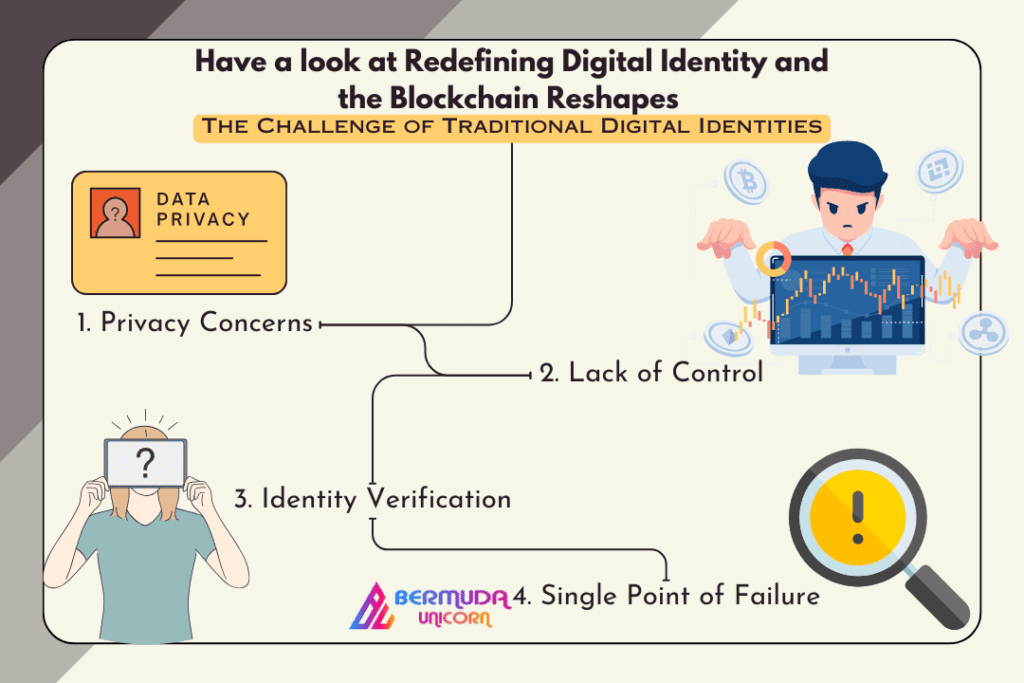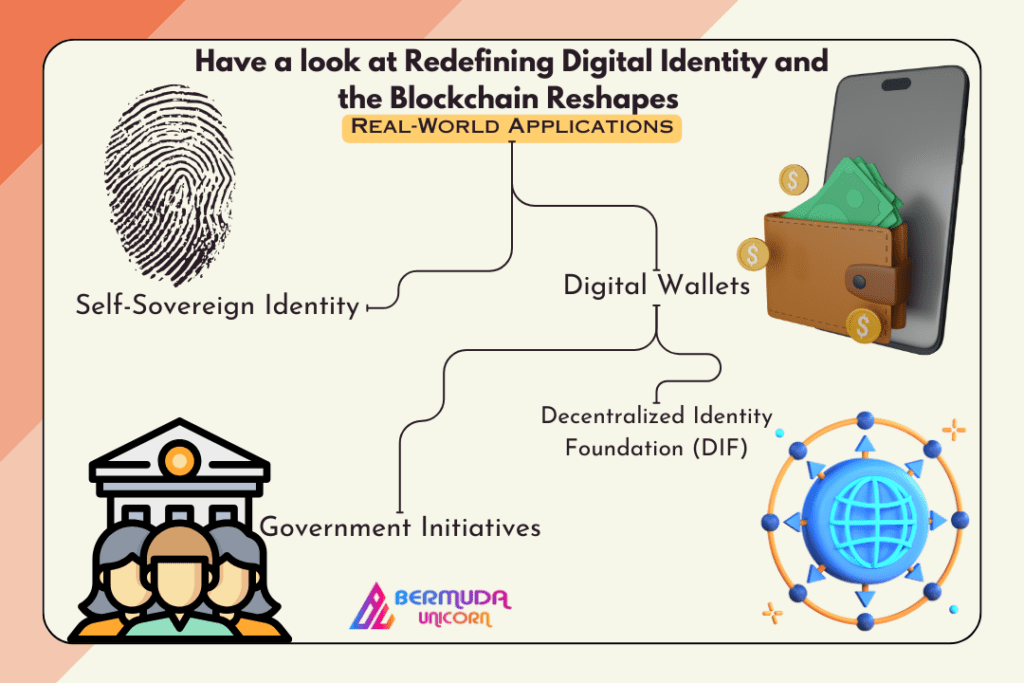![]()

Introduction
The advent of the digital era has revolutionized our lifestyle, profession, and communication with the global community. In this era, our online presence, often referred to as our digital identity, has become an integral part of our lives. We rely on digital identities for a multitude of daily activities, from social media profiles and online banking to e-commerce accounts and email. However, how we manage and protect our digital identities needs a redefinition. Traditional centralized systems have proven to be vulnerable to data breaches and identity theft, prompting the exploration of more secure and decentralized solutions. Blockchain technology has emerged as a promising candidate for reshaping digital identities and enhancing online security. In this comprehensive exploration, we will delve into how blockchain is redefining digital identity and its potential to revolutionize the way we manage our online personas.
The Challenge of Traditional Digital Identities
Traditional digital identities are typically managed by centralized authorities such as government agencies, social media platforms, or financial institutions. These systems offer convenience and accessibility, but they also come with a set of challenges:
1. Privacy Concerns:
Centralized entities often collect vast amounts of personal data, raising concerns about privacy and data security. Data breaches and the misuse of personal information can lead to identity theft and other cybercrimes.
2. Lack of Control:
Users have limited control over their personal information once it’s in the hands of centralized organizations. They can’t easily revoke access or decide who can access their data.

3. Identity Verification:
Identity verification processes can be cumbersome and time-consuming, requiring users to provide the same information repeatedly to different service providers.
4. Single Point of Failure:
Centralized systems are vulnerable to single points of failure, where a breach at the authority’s end can lead to widespread security issues, affecting countless individuals.
How Blockchain Reshapes Digital Identities
Blockchain technology, celebrated for its decentralized and secure nature, is poised to address many of the challenges associated with traditional digital identities. Here’s how:
1. Self-Sovereign Identities:
With blockchain, users can create self-sovereign identities, granting them full control over their personal information. They can choose what data to share and with whom, greatly enhancing privacy and data security.
2. Decentralization:
Blockchain operates on a distributed ledger, meaning there is no central point of control. This makes it highly resistant to data breaches and hacking attempts, providing a more secure environment for digital identities.
3. Improved Verification:
Blockchain enables efficient and secure identity verification through the use of digital signatures and cryptographic methods. Users can prove their identity without revealing unnecessary information, reducing the risk of identity theft.
4. Interoperability:
Blockchain can facilitate the interoperability of digital identities across various platforms and services. Users can use a single digital identity for multiple purposes, eliminating the need to create separate accounts for each service. This not only streamlines user experience but also reduces the risk of fragmented, vulnerable identity silos.
5. Trust and Transparency:
The transparent and immutable nature of blockchain transactions fosters trust in the system. Users can verify the legitimacy of identity claims, reducing the risk of fraud and impersonation.
Real-World Applications
Blockchain is already making its mark in reshaping digital identities, with several projects and initiatives demonstrating its potential:
1. Self-Sovereign Identity (SSI):
SSI systems, such as the Sovrin Network and Microsoft’s Identity Overlay Network, allow users to create and control their digital identities on the blockchain, enhancing privacy and security. Users can choose which aspects of their identity to share, and they can revoke access at any time, putting them in full control.

2. Digital Wallets:
Blockchain-based digital wallets like Metamask and Trust Wallet provide users with secure storage for their digital assets and identities. These wallets enable seamless interaction with decentralized applications (dApps) while ensuring the security of users’ digital identities and assets.
3. Government Initiatives:
Some forward-thinking governments are exploring blockchain for identity management. For example, Estonia’s e-Residency program utilizes blockchain for secure digital identities, allowing non-residents to access Estonian e-services and engage in international business transactions.
4. Decentralized Identity Solutions:
Organizations like the Decentralized Identity Foundation (DIF) work on open standards for blockchain-based digital identities, promoting interoperability and user-centric identity management. These initiatives aim to create a unified framework for digital identity that is both secure and user-controlled.
Conclusion
The current digital identity landscape needs a fundamental redefinition to address issues related to privacy, security, and control. Blockchain technology offers a promising solution by enabling self-sovereign identities, decentralization, and enhanced security. As the adoption of blockchain continues to grow, we can expect a significant shift in the way we manage our online personas.
With blockchain, the future of digital identities is one where users have the power to own, control, and protect their online presence, providing a safer and more user-centric digital world. The transition to blockchain-based digital identities may not happen overnight, but as the technology matures and gains wider acceptance, it has the potential to transform the way we interact online, putting users back in control of their personal information and ensuring a more secure and private digital environment. The redefinition of digital identity is well underway, and blockchain is leading the way in reshaping our online personas for a more secure and user-centric future.
Frequently Asked Questions (FAQs)
1. What is digital identity, and why does it need to be redefined?
– Digital identity refers to the set of information and attributes that represent an individual in the digital world. It includes personal information, online profiles, and access credentials. It needs to be redefined because traditional centralized systems for managing digital identities have vulnerabilities related to privacy, security, and control.
2. How does blockchain enhance digital identity security?
– Blockchain enhances security through decentralization, transparency, and cryptographic methods. It eliminates a central point of control, making it highly resistant to data breaches. The transparent and immutable nature of blockchain transactions fosters trust, and cryptographic methods ensure secure identity verification.
3. What is a self-sovereign identity, and how does blockchain enable it?
– A self-sovereign identity (SSI) is a concept that empowers individuals to have full control over their digital identities. Blockchain enables SSI by allowing users to create, manage, and share their personal information as they see fit. Users can choose which aspects of their identity to share and revoke access at any time, putting them in control.
4. Can blockchain be used for government-issued IDs?
– Yes, blockchain can be used for government-issued IDs. Some governments, like Estonia, have already explored blockchain for identity management. Blockchain technology provides a secure and efficient way to issue and verify government-issued IDs, enhancing privacy and security.
5. What are digital wallets, and how do they relate to digital identities?
– Digital wallets are applications that allow users to store and manage their digital assets, including cryptocurrencies, and digital identities. They play a crucial role in securing and controlling access to personal information and assets in the digital world, making them a key component of blockchain-based digital identity systems.
